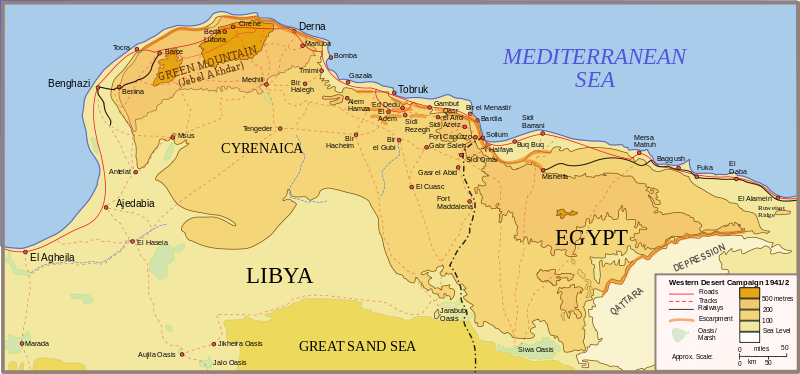ITALIANS PUSH INTO EGYPT, IMPERIL SUEZ CANAL
Cairo, Egypt · September 13, 1940
On this date in 1940, 250,000 soldiers of the Italian Tenth Army under the command of Marshal Rodolfo Graziani crossed from the Italian colony of Libya into Egypt (see map), where British troops were protecting the Suez Canal, the vital waterway to the Middle Eastern oilfields and beyond that to British holdings in India, Burma, Singapore, and Malaya. Four months earlier, on June 10, 1940, Italian dictator Benito Mussolini had declared war on Great Britain and France. Graziani’s incursion into Egypt was Italy’s first offensive against British forces in North Africa. The Tenth Army halted 60 miles inside Egypt and dug in. Only 30,000 British defenders were available to challenge the invaders, so the Italian halt was likely due to their being largely unmechanized and unaware of British strength, as well as the potential of the Royal Navy to interfere with Italian supply lines in the Mediterranean region. Nearly three months later, on December 8, 1940, the British Middle East Command, composed of British, Indian, and Australian troops under Gen. Archibald Wavell, launched Operation Compass (December 8, 1940 to February 9, 1941). Originally planned in great secrecy as an extended raid, Compass succeeded in capturing tens of thousands of enemy troops. The Tenth Army was virtually destroyed, and it seemed that the Italians would be swept from North Africa. At that crucial moment, however, British Prime Minister Winston Churchill ordered the advance stopped and troops dispatched to defend Greece, which Mussolini’s armies had invaded on October 28, 1940, from Italian-occupied Albania lying on Greece’s northern frontier. Mussolini moved quickly to reinforce Italian garrisons in Western Libya (Tripolitania), bringing troop strength up to 150,000. Weeks later, in February 1941, the nucleus of the German Afrika Korps led by the energetic young Gen. Erwin Rommel arrived in Libya to reinforce Adolf Hitler’s Axis partner. Neither the Italians nor the Germans would be finished off until mid-May 1943, when their armies stood down and surrendered to the Allies, whose presence had been strengthened by the Torch landings in Northwest Africa in November 1942. More than 250,000 Italian and German prisoners were taken, which ended the Axis threat in North Africa.
[amazon_carousel widget_type=”ASINList” width=”600″ height=”200″ title=”Recommended Reading” market_place=”US” shuffle_products=”False” show_border=”False” asin=”1846032903,0806143053,1848848072,1855329670,1780968558,1849087377,0521509718,1849085013,0811705919,0764321404″ /]
Cyrenaica, Eastern Libya, and Western Egypt, 1941–1942, Site of See-Saw Engagements Between Axis and Allied Armies
 |
Above: Map of Cyrenaica, Eastern Libya, and Western Egypt, 1941–1942.
 |  |
Left: Approximately 25,000 Italians defended the important harbor town of Tobruk in Cyrenaica (exact center in above map). After a twelve-day period building up forces around Tobruk and softening up Italian defenses with heavy artillery bombardment, Australian, British, and Free French units took the town one day after launching an attack on January 21, 1941. The Tobruk prize yielded over 25,000 prisoners, 236 field and medium guns, 62 tankettes, 23 M11/39 medium tanks, and more than 200 other vehicles.
![]()
Right: British Vickers Mark VIB light tanks on desert patrol, August 2, 1940. First produced in 1936 for the dual roles of reconnaissance and colonial warfare, the lightly armored Mark VI possessed a crew of three—commander/radio operator, gunner, and driver. Its main armament was a .50-in Vickers machine gun. In a December 12, 1940, attack, the light tanks got bogged down in salt pans and were severely mauled by the Italians.
 |  |
Left: Like the lightly armored Vickers Mark VI tank, Italy’s Fiat L3 tankettes were machine gun-armed. First built in 1933, L3s and their variants carried a two-man crew and were mainly used for light infantry support and reconnaissance. They saw service against Haile Selassie’s army in Ethiopia (1935–1936) and in Spain, France, the Balkans, Libya, and Italian East Africa. In this photo an L3 cc on the left and an L3/35 on the right are shown here on the harbor road overlooking Bardia, Libya.
![]()
Right: Operation Compass was a complete success. Allied forces advanced 500 miles from inside Egypt to central Libya, suffering just over 1,700 casualties and capturing 130,000 Italian prisoners, including 22 generals. The Italians lost 400 tanks, nearly 1,300 artillery pieces, and a thousand aircraft. In this photo from January 6, 1941, a column of Italian prisoners captured during the assault on Bardia, Libya, is marched to a British army base.
Axis and Allied Forces Battle for Control of North Africa, 1940–1943
![]()

 History buffs, there is good news! The Daily Chronicles of World War II is now available as an ebook for $4.99 on Amazon.com. Containing a year’s worth of dated entries from this website, the ebook brings the story of this tumultuous era to life in a compelling, authoritative, and succinct manner. Featuring inventive navigation aids, the ebook enables readers to instantly move forward or backward by month and date to different dated entries. Simple and elegant! Click
History buffs, there is good news! The Daily Chronicles of World War II is now available as an ebook for $4.99 on Amazon.com. Containing a year’s worth of dated entries from this website, the ebook brings the story of this tumultuous era to life in a compelling, authoritative, and succinct manner. Featuring inventive navigation aids, the ebook enables readers to instantly move forward or backward by month and date to different dated entries. Simple and elegant! Click 











